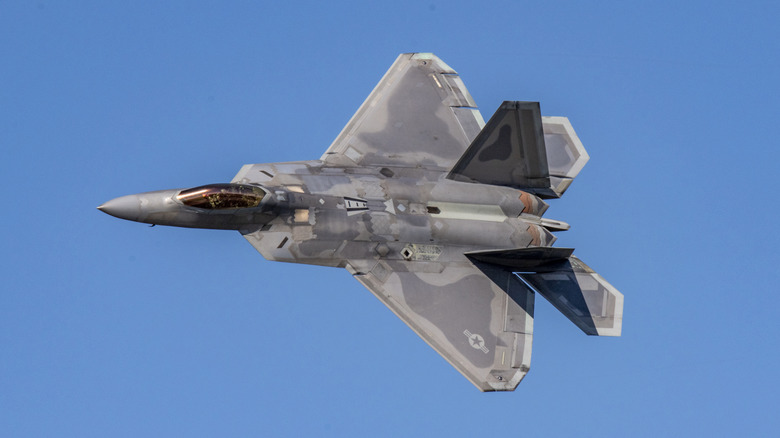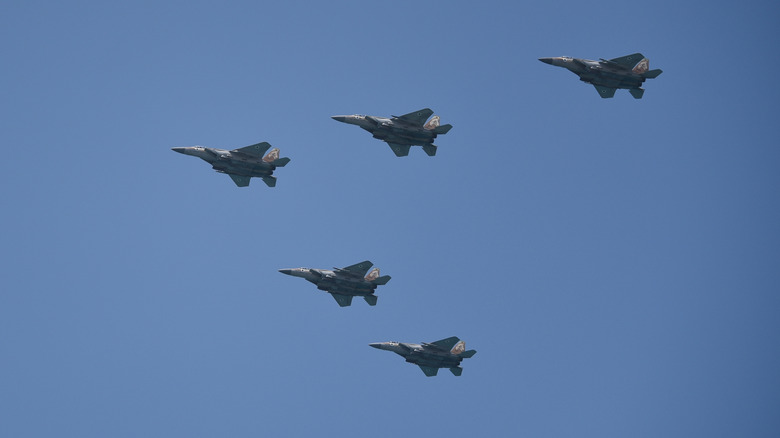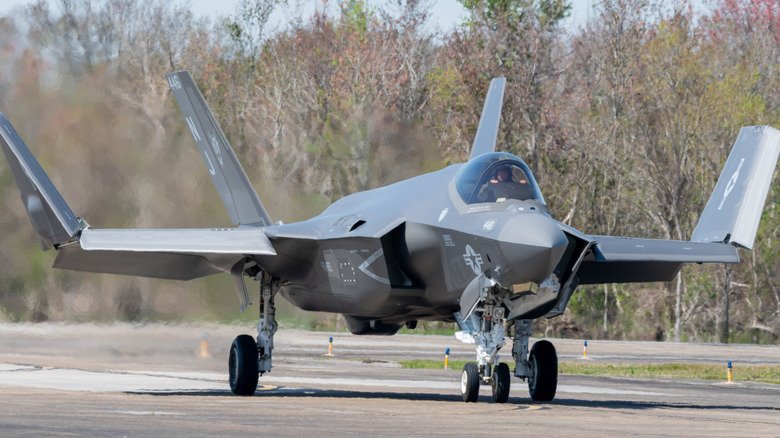Why Doesn't The US Navy Fly The F-22 Raptor?
Throughout the past several decades, military jets have become a staple of the United States Armed Forces. While not all models have stuck around for the long haul to become well-known by the public, a few have become symbols of different military branches. Among the most famous is arguably the stealthiest fighter jet ever built, Lockheed Martin's F-22 Raptor. It's fast, durable, and one of the most advanced military jets on Earth. Still, all of these qualities don't make it suitable for just any task. For instance, the F-22 isn't utilized by the U.S. Navy because of a few serious drawbacks.
Just as important to fifth-generation fighter jets being undetectable is its ability to land. An F-22 is intended for landings on full-length runways, with plenty of room to reduce speed once it touches down. Not only is an aircraft carrier lacking in ample space for an F-22 to slowly come to a stop, but its landing gear couldn't endure such a landing. The weight of 43,340 pounds coming in at a high speed with little room to stop is a recipe for disaster.
There's also the matter of takeoffs, which on aircraft carriers are performed by catapulting. This involves a specialized setup that effectively jumpstarts the jet, allowing it to pick up immense speed at a short distance. The F-22 isn't reinforced to sustain such launches. However, could the military make the necessary changes for the Navy to use it?
F-22s would need serious overhauls to become aircraft carrier-ready
To optimize the F-22 Raptor for aircraft carrier landings and takeoffs, some extensive modifications would have to be made. The first would be a reduction to the aircraft's weight since its current landing gear can't handle coming to an abrupt stop with tens of thousands of pounds in tow. Thus, the airframe — encompassing such elements as the fuselage, wings, tail, and airflow control surfaces — would demand a major overhaul.
Pulling this off, without compromising durability for the sake of catapulting, would ultimately be a time-consuming endeavor that would only add to the F-22's costly price tag. On top of its anatomy needing modifications, the folks trained to pilot them would have to change their training regimen as well. As of this writing, F-22 pilots aren't trained in carrier landings, which would be undeniably essential for anyone hoping to be a Navy F-22 pilot.
It takes a lot to become a pilot, as F-35 pilots in the Air Force can attest, so adding a whole other layer to training for F-22 pilots likely wouldn't be welcome. Therefore, while it is theoretically possible for F-22s to become Navy-useable, it would be difficult to justify the time, effort, and funds needed. As great as the F-22 is, evidently, it's not quite an all-purpose vehicle, and it would take some sweeping changes to make it Navy-ready. Thus, another jet has become the Navy's aircraft of choice.
What does the Navy use instead of the F-22?
In addition to the various impracticalities of tweaking the F-22 to be aircraft carrier-ready, it's on its way out the door anyway. The F-22 has indeed been discontinued, with the F-47 seemingly set to take its place. This replacement won't impact the Navy much at all, seeing as it instead utilizes a completely different jet that can cover much of the same ground as the F-22. The Navy's F-22 equivalent is the F-35C, which is also produced by Lockheed Martin.
Lockheed designed this variant of the F-35 specifically for aircraft carrier operations, unlike the F-22. Its wings, as well as its landing gear, were engineered to withstand catapult launches and landings requiring the quick reduction of speed over short distances. Moreover, the tips of the wings can fold in, making room on either side for other aircraft while stationary on an aircraft carrier.
Not to mention, it can reach speeds of well over 1,000 mph, can carry over 18,000 pounds of internal and external weaponry, and its advanced technology makes it stealthy while also ensuring pilots are well aware of their surroundings. While the F-22 Raptor undoubtedly left its mark on military aviation history, it was simply never destined for the Navy. Without major changes, it would never cooperate with the average aircraft carrier like an F-35C does.


